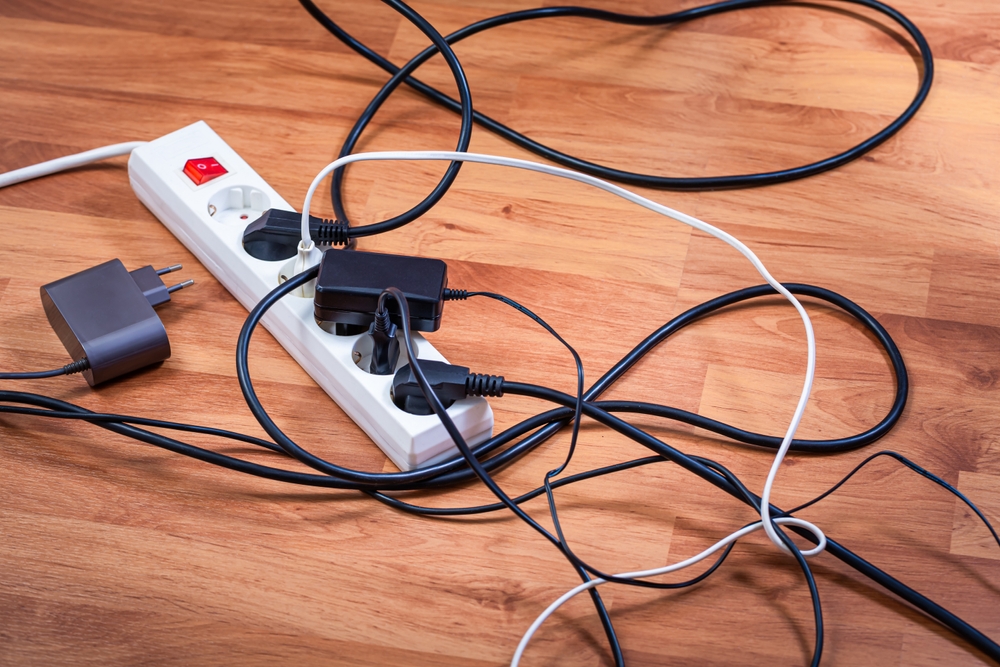
We all love the convenience of extension cords and surge protectors. Plug something in, and power is just a foot or two away. But electricians across the country warn that this convenience can become dangerous when misused. Many household disasters start with a device that should never have been plugged into an extension cord or surge protector. Recognizing which devices pose risks helps you protect your home, your gear, and yourself. Below are seven devices that professionals say should always go straight into a wall outlet, not through extensions or strips.
1. Space Heaters and Portable Heaters
Space heaters draw serious power, often between 1,000 and 1,500 watts (or more). Extension cords and surge protectors are rarely rated for that sustained draw, and the cord’s wiring can overheat. Overheating wires are a top cause of electrical fires in homes. Even if a protector has a built-in circuit breaker, that doesn’t guarantee safe operation when used with a high-wattage heater. The electrician’s rule: heaters must always plug directly into a properly grounded wall receptacle.
2. Refrigerators, Freezers & Other Large Appliances
Appliances with motors (like refrigerators, freezers, air conditioners, or dishwashers) have a high “startup surge” of current when their compressor kicks in. That momentary draw can overwhelm an extension cord or surge protector that was barely handling the running load. The consequences? Tripped breakers, melted insulation, or worst case, short circuits. Moreover, these appliances run continuously, increasing the risk that a cord overheats over time. To ensure safety and longevity, they should always be plugged into a dedicated wall outlet.
3. Microwave Ovens and Toaster Ovens
Microwaves, toaster ovens, and similar cooking devices combine high wattage with potentially variable loads. They spike power usage when heating, which stresses any intermediate wiring. Plugging them into an extension cord or surge protector can lead to voltage drops and overheated cables. Since people often use such devices for minutes at a stretch (or longer), heat buildup can sneak up on you. For kitchen safety, these devices always belong plugged directly into a wall outlet on a circuit rated for them.
4. Space Compressors, Shop Tools & Power Tools
Power tools (saws, drills, compressors, lawn equipment) are designed to pull high currents, especially under load. When used through an extension cord, the voltage drop can force the tool to draw even more current, accelerating wear or causing failure. The added resistance of connectors, cords, and plugs compounds the stress. Many workshop fires begin at tool cords that can’t handle the load. Plug all heavy-duty tools into dedicated, properly rated outlets, not via strips or standard extensions.
5. Hair Dryers, Curling Tools & High-Heat Personal Devices
Surprisingly, hair dryers and styling tools are power-hungry offenders. Professional hair tools can draw as much as 1,800 to 2,000 watts, which is far too much for most extension cords. Even if the strip doesn’t immediately fail, the connectors can become warm over time, leading to melting or fire hazards. Because these devices are used daily and generate heat, the risks compound. Best practice: plug them directly into a wall socket, not through any interim device.
6. Window Air Conditioners & Portable AC Units
Like refrigerators, air conditioners have motors that draw heavily on startup. They often demand more current than a typical extension or surge protector can safely supply. Running them through a weak link in the cord chain risks voltage sag, overheating, or even blowing circuits. Over time, continuous stress may damage the internal components of the AC unit itself. Always use a dedicated wall outlet or circuit sized for the load.
7. Electric Ovens, Stoves & Dishwashers
Electrical ovens, stoves, dishwashers, and other permanent kitchen appliances demand high amperage and dedicated circuits. They should never, under any circumstances, be plugged into extension cords or surge protectors. The wiring in the walls (and appliances) is sized for direct connection and proper insulation. Introducing intermediate cords or strips is a shortcut to overheating, fire, or serious damage. These major appliances must always be hardwired or plugged into properly installed outlets.
Why These Rules Aren’t Optional
Extension cord safety isn’t just about avoiding clutter. It’s about preventing disaster. Every plug, connector, and joint introduces resistance, which generates heat under load. That means a chain of cords is a chain of risks. Also, extension cords are meant for temporary use, never as permanent wiring. Coiled or hidden cords trap heat and raise hazard potential. Electricians stress: always respect the ratings; match the device to wiring and outlet capacity. When it comes to extension cord safety, remember this simple mantra: if it draws heat, it probably needs a wall socket.
What’s the riskiest device you’ve ever caught plugged into an extension cord, and how did you handle it? Share your stories in the comments below!
What to Read Next
- Can Using the Wrong Extension Cord Violate Fire Code?
- Why DIY Electrical Work Is the Fastest Way to Lose Your House
- 10 DIY Hacks That Quietly Ruin Your Electrical Wiring
- 7 Garage Mistakes That Could Be Driving Your Electric Bill Up
- Why Electrical Safety Mistakes Keep Sending Men to the ER
The post Electrician Warns: Never Plug These 7 Devices Into Extension Cords or Surge Protectors appeared first on Clever Dude Personal Finance & Money.







